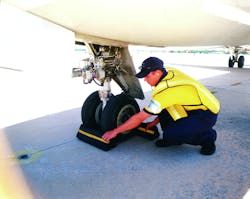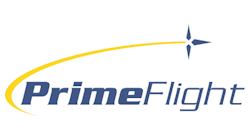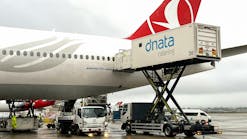PrimeFlight’s Data-Driven Ground Support
PrimeFlight Aviation Services, based in Nashville, TN, employs more than 3,500 people in ramp services, baggage handling, cabin cleaning and passenger assistance to airlines across the United States.
“To support our customer’s customer service needs is our basic core philosophy,” says Mark Marudas, vice president of operations and business development. “To accomplish that task, we put a lot of emphasis on ensuring that we develop exceptional people and have a system in place that supports our various services that can be standardized through a large network to enhance passenger experience and add value to an airline’s brand.”
Buried in that long quote is the phrase “have a system” that’s one key to the company’s focus on brand management.
X-WASH
We’ll get to that system in a moment, but consider the company’s latest service. The new PrimeFlight X-Wash is a specialized division that cleans a plane’s exterior from crown to tail.
There can’t be too many bigger representations of a company’s brand than a gleaming aircraft parked and ready to go at a gate dressed in its distinctive livery.
Acid rain and sleet, however, not to mention deicing spray, runway salt and even improper cleaning can all take their toll on an expensive plane’s skin.
There are two ways to clean the exterior of an aircraft, relates Steve Leonard, senior vice president of business development. One type would be a “wet wash” that’s done with pressure washers that is not all that much different from a scaled-up version of a car wash.
However, the soapy discharge left behind creates an environmental problem since government agencies from federal to state to local do not want wet wash leftovers overwhelming drainage and wastewater systems.
“As a result, there’s been a movement to take a different approach,” Leonard adds. “It’s not unlike a wax process for a car except obviously on a much larger scale.”
That’s the process that Leonard says is the future of exterior washes and what the company rolled out recently in Newark, NJ and Sacramento, CA.
A lot of work goes into preparing a plane even before the extensive cleaning process begins. PrimeFlight X-Wash crews conduct extensive filming of each operation to highlight, for example, that landing gear and brakes are covered with secured tarps to prevent any chemical splash. Or that additional protection is installed to take care of airspeed and altitude-sensing ports.
Leonard says cleaning one plane the X-Wash way can take 20 man-hours. The operation also includes further detailed service to engines, pylons and landing gear.
Afterward, the protective covers and tarps are placed in sealed containers for inspection. And a final filming of the cleaned aircraft takes place, including from the crown, top of the wings, APU, engine insides, cowlings and landing gear to ensure no equipment or FOD is left behind.
The PrimeFlight X-Wash service extends paint life by removing oxidants and potentially harmful chemicals and adding a protective UV coating that further protects a plane’s appearance.
PrimeFlight’s other specialty cleaning services include cleaning and disinfecting cargo bins and cleaning wheel wells and flap tracks, all of which contribute to a clean, smooth aircraft – and that adds up, Leonard says, to less drag and, therefore, increased fuel economy, as well as minimized corrosion.
Although PrimeFlight started offering the service at two locations, the company also has service proposals to almost all the major domestic airlines. In addition to exterior cleaning, its crews have always been busy taking care of the interior cleaning, too.
“Our appearance operations currently make up about 30 percent of our service base and we’ve seen a significant expansion on those services over the past eight years,” Marubas says.
THE SYSTEM
Keeping much of this activity humming behind the scenes is a management information system called SynTrack.
While management has tweaked the system to fit the needs of an airport service firm, the basic software product actually comes from the hospital industry where its primary purpose is to automate the work flow of transporting patients using straight-forward, intuitive orders transmitted to hand-held devices. (For more on the system’s origins within PrimeFlight, see our sidebar “SSR Service”).
PrimeFlight continues to use it for its original purpose of dispatching equipment and personnel, but management continues to modify it to better track service performance.
“The system, for example, allows us to easily complete quality control checks on cleaning,” Leonard explains. “Our auditors can go through a checklist on the handheld devices and immediately upload the results into a file that is accessible to local management to determine how well we are cleaning aircrafts.”
With its version of SynTrack, PrimeFlight gets real-time visibility to the location of equipment, personnel and passengers that the company sees as ultimately tying together all its ground support and passenger services.
“We measure everything we possibly can to ensure we are meeting our customer’s expectations,” Marubas adds. “SynTrack allows us to expand on that capability by setting best practices standards throughout all our locations and giving more immediate feedback to our employees on meeting those standards.”
In summary, here’s what the system provides:
- Optimizes schedules to support customer service standards based on changing schedules, volume or requirements.
- Supports seasonal staffing and scheduling adjustments.
- Benchmarks productivity to ensure optimal performance and productivity.
- Provides service quality and productivity trend analyses.
“It’s a great tool to improve quality, reduce costs and achieve efficiencies,” Leonard sums up.
The company started using SynTrack in 2010 at two airports and has since implemented the program in nine other locations with a total of 12 sites expected before the year’s end.
Over that time, PrimeFlight also decided to upgrade all its handheld devices to the Motorola ES400 PDA.
“It looks like an over-sized iPhone,” Leonard says. Employees easily get instructions through the device and can “time stamp” procedures from beginning to end. The PDA also has the standard text and two-way communications.
“We have the ability to communicate instantly in multiple modes,” Leonard says. “If there’s information that needs to be communicated about a specific flight that’s delayed, for example, we can stream that over our text system.”
A key feature is that large touch screen. The SynTrack software allows the company to configure the screen so that any number of activities can be organized and tracked by time and location.
“When events are within our set standards, they stay green,” Leonard says of the Motorola’s screen. “But if we are approaching that minimum time that we’re allowed to complete the job, it will start to flash.”
Those challenges can be communicated to a supervisor who can immediately make needed adjustments. Management, however, can use the important information captured by the process to determine at a later time, if there are bigger issues that need to be addressed in order to get the job done promptly.
“From a service perspective, that’s huge,” Leonard adds, “and it leaves absolutely nothing to chance.”
‘EXCEPTIONAL PEOPLE’
But technology only helps run the show behind the scenes. What about out front?
“We are focused on technology,” Leonard explains. “but we also keenly focus on people.”
Considering the systematic approach we’ve discussed in terms of PrimeFlight’s customer service operations, it’s no surprise that the company also has a system in place to hire and train its recruits and employees.
Recruiting, for example, includes a test developed by a well-known testing company that’s also been tweaked by PrimeFlight management to better measure the aptitude of prospective employees specifically for ground support and passenger service occupations.
“We do put in a lot of time in our systematic approach to recruiting, testing, interviewing and hiring, and in training our general managers to support this process,” Marudas says.
A Ground Support Worldwide article on PrimeFlight published in 2004 outlined some of the key traits the company continues to pinpoint in its future employees:
- First and foremost, people skills.
- Second, the ability to develop a strong interest in the job and the desire to develop an effortless relationship with the customer.
- And, finally, technical skills necessary for the specific job.
Afterward, Marubas says the key feature done at orientation is to ensure that the company’s philosophy of customer service and meeting customer expectations is understood and embraced.
“That’s the core foundation of what we do,” Marubas adds. “The underlying service mindset of doing whatever it takes to get the job done is paramount.”
From there, the company offers training that could be in front of a computer or paired up with another seasoned employee.
“On-the-job training is critical,” Marubas explains. “We ensure that our employees are effectively trained to perform their job functions before we let them support those services on their own.”
In addition, PrimeFlight developed a cohesive safety, quality and compliance training program rather than a stand-alone safety curriculum. The company believes this method makes safe behavior second nature to its workers.
Recurrent training is required each year to refresh knowledge and implement any changes or other safety updates.
On a related note, more than $200,000 to frontline employees has been paid out since 2007 as part of a safety-based incentive program.






